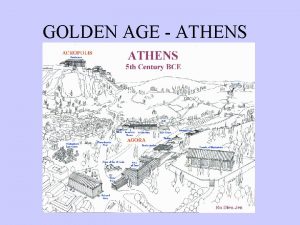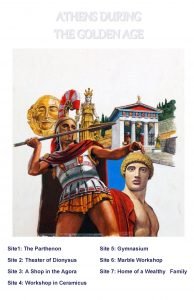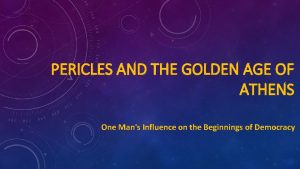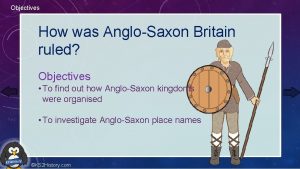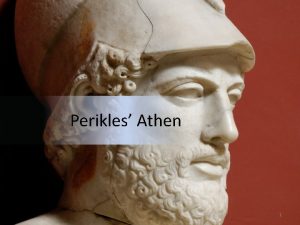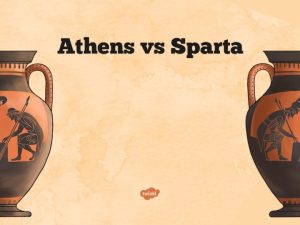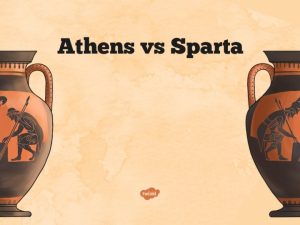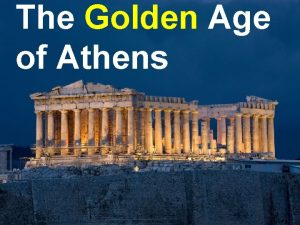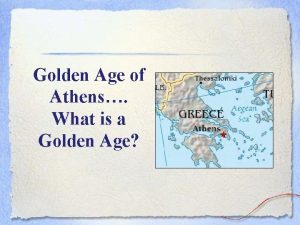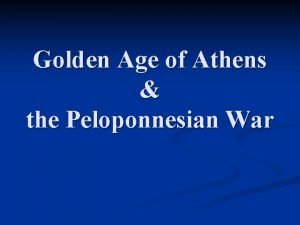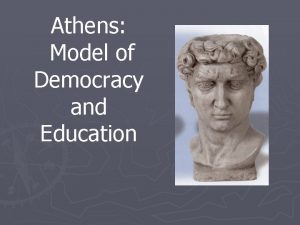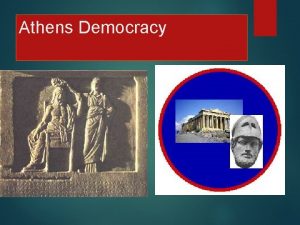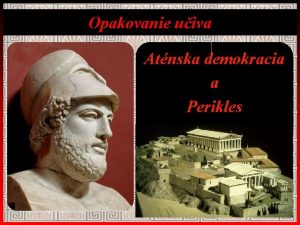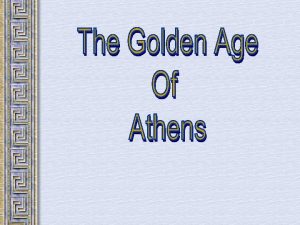Golden Athens n Perikles ruled Athens fortyfive years

















- Slides: 17


“Golden” Athens n Perikles ruled Athens forty-five years (469 -429 BCE); he promoted the arts and literature; this was a chief reason Athens holds the reputation of being the educational and cultural centre of the ancient Greek world. He started an ambitious project that built most of the surviving structures on the Acropolis (including the Parthenon). This project beautified the city, exhibited its glory, and gave work to the people. Pericles was the most passionate proponet of Athenian Democracy and , so historians called him “the first citizen”.

n Perikles was determined to spend the wealth of Athens on the Athenian citizens and the development of the city, which resulted in the construction of some of the most enduring and artistically profound structures ever to grace the Greek landscape, masterpieces like: the Parthenon, the Odeum, the Propylaea and the protective Long Wall (which went from Athens to the nearby port of Piraeus); these civic projects employed vast numbers of workers and gave opportunities to otherwise underemployed Athenians.

n n A religious rock, a city fortress, but more than anything else, the reflection of the city's changing historical destiny. The house of goddess Athena, according to Homer, was, in prehistoric times, palace of king Erechtheus and then citadel, fortress for the Athenians when in the 12 th century people from the north occupied the Mycenaean citadels. The duality was reflected on the Acropolis hill with the coexistence of Doric (austere, masculine) and Ionic (ornate, feminine) elements.

n With the relocation of the administrative center of the Athenian life in the area of the Agora, the Acropolis hill was left to become a religious center, yet always incorporating political messages. During the period of the Athenian Empire, the fusion of the two orders (Doric-Ionic) expressed the subliminal political messages that Athens wanted to convey as the "leader" of all citystates (Ionian-Dorian). A union that emphasized the Athenian supremacy and power.


Philosophy n Greek philosophy focused on the role of reason and inquiry. In many ways it paved the way both to modern science and modern philosophy. Clear unbroken lines of influence lead from Greek philosophers to the Renaissance, the Enlightenment and the secular sciences of the modern day.

n Socrates (circa 470– 399 BC) was an ancient Greek philosopher who is widely credited for laying the foundation for Western philosophy. The most important source of information about Socrates is Plato's dialogues portray Socrates as a teacher who denies having disciples, as a man of reason who obeys a divine voice in his head, and a pious man who is executed for the state's own expediency. Socrates disparages the pleasures of the senses, yet is excited by beauty; he is devoted to the education of the citizens of Athens, yet indifferent to his own sons. He is often held to be the founder of Western philosophy, and its most influential practitioner.



n n The philosopher Aristotle theorized in his work The Poetics that tragedy results in a catharsis (emotional cleansing) of healing for the audience through their experience of emotions such as pity, anger, disgust and terror in response to the suffering of the characters in the drama who progress through inner compulsionspsychological or religioustowards self-knowledge and death. He considers it superior when a character passes from good fortune to bad rather than the reverse.

The Athenian democracy (sometimes called classical democracy) was the democratic system developed in the Greek city-state of Athens. Other Greek cities set up democracies, most but not all following an Athenian model, but none were as powerful or as stable (or as welldocumented) as that of Athens. It remains a unique and intriguing experiment in direct democracy where the people do not elect representatives to vote on their behalf but vote on legislation and executive bills in their own right. The participants participated with no reference to economic class on a scale that was truly phenomenal.

n n Solon (594 BC), Cleisthenes (508 BC), and Ephialtes of Athens (462 BC) all contributed to the development of Athenian democracy. Historians differ on which of them was responsible for which institutions, and which of them most represented a truly democratic movement. It is most usual to date Athenian democracy from Cleisthenes, since Solon's constitution broke down and was replaced by the tyrant Peisistratus, whereas Ephialtes revised Cleisthenes' constitution relatively peacefully. The greatest and longest-lasting democratic leader was Pericles; after his death, Athenian democracy was twice briefly interrupted by oligarchic revolution towards the end of the Peloponnesian War. It was modified somewhat after it was restored under Eucleides.

The standard format of Greek public buildings is known from surviving examples such as the Parthenon and the Hephaesteum at Athens, the group at Pasteum, the temple complex at Selinunte (Selinus) and the sanctuaries at Agrigentum. Most buildings were rectangular and made from limestone of which Greece has an abundance, and which was cut into large blocks and dressed. Marble was an expensive building material in Greece: high quality marble came only from Mt. Pentelicus in Attica and from a few islands such as Paros, and its transportation in large blocks was difficult. It was used mainly for sculptural decoration, not structurally, except in the very grandest buildings of the Classical period such as the Parthenon.



The achievements of that age can be observed even in our time! The ancient Greek thinking is the root of almost every modern art! They have shown the way for the civilization to pass in every nation!. The people who have represented those who wanted their freedom were based on the writings of the Athenian philosophers to express their will. From those people we now have a great source of knowledge and with it we can make the world a better place. So it isn’t really a surprise that the ancient Greece is known in every corner of this world since everyone deserves to know it’s greatness and glory.
 Perikles xanthippus
Perikles xanthippus Perikles
Perikles During the golden age of athens, a tribute was
During the golden age of athens, a tribute was Athens during the golden age
Athens during the golden age During the golden age of athens, male citizens
During the golden age of athens, male citizens 300 solar years to lunar years
300 solar years to lunar years Four score and seven years ago
Four score and seven years ago Sheep years to human years
Sheep years to human years Stresemann golden years
Stresemann golden years Modified fibonacci sequence
Modified fibonacci sequence The golden stairs golden ratio
The golden stairs golden ratio When the moors ruled spain
When the moors ruled spain Once upon a time there was a very bad king
Once upon a time there was a very bad king Egypt social classes
Egypt social classes Napoleon's relatives ruled
Napoleon's relatives ruled What was life like for the jews in greek-ruled lands?
What was life like for the jews in greek-ruled lands? How was anglo-saxon britain ruled?
How was anglo-saxon britain ruled? Evidence ruled inadmissible
Evidence ruled inadmissible


